| “One who fearlessly penetrates the depth, learns the Truth sooner or later. While being on the surface, one can only observe a distorted reflection of what is hidden in the depth…” А. Novykh. AllatRa |
This article contains brief review and analysis of Trypillian anthropomorphic plastic art (hereinafter referred to as TAPA) or, in other words, anthropomorphic items made of burnt clay and associated with Cucuteni-Trypillian archaeological culture. The term anthropomorphic originates from the Greek word anthropomorphos and means “having a human or humanoid image”.
The purpose of this work is to familiarize readers with the aforesaid original culture, as well as to thoroughly extend knowledge of such a unique cultural phenomenon as TAPA. For this we shall analyse it not only from the viewpoint of mainstream science, but also from the perspective of sacral knowledge about the human nature as presented in the books by Anastasia Novykh.
Before we start analysing TAPA, it is necessary to provide brief characteristics of the culture discussed.
А) Brief history of the culture discovery
In 1884, Romanian researcher Theodor Burada found the first artefacts of this culture near the village of Cucuteni, Romania. Almost simultaneously with this event, in 1893 the archaeologist of Czech origin Vikentiy Khvoyka (Chvojka) found similar artefacts in the territory of Kiev which at that time was a part of the Russian Empire.
|
|
|
Several years later, in 1896 Khvoyka discovered artefacts of the same kind near the village of Trypillia (Tripolye) not far from Kiev. Thereafter systemic excavations and studies of this culture started. After a certain period of time the artefacts collected in various places were compared, and scientists came to the conclusion that all of them belonged to the same mega culture. Thus, based on the names of the villages near which the first artefacts were discovered, this culture got a corresponding name – the Cucuteni-Tripolye (Trypillian in Ukrainian) archaeological culture. |
Vikentiy Khvoyka
This is the official version of the history of the culture discovery. To ensure the information completeness, several little-known facts should further be added. One fact is that as long ago as in the 1750s excavations were carried out in Western Ukraine for the purpose of replenishment of a private collection. Another fact is that in 1822 VertebaCave was accidentally found, where Trypillian artefacts were discovered as well.
Finishing this subsection, let me only say that today there are over 4,500 places where artefacts of this culture have been found.
B) Brief history of the civilization discovery
“This is impossible because it is never possible!” well-known archaeologist Tatyana Passek exclaimed, quoting the famous writer, when she was listening to the military topographer Konstantin Shishkin telling about an incredible discovery he had made in the 1960s in Ukraine not far from Uman. The thing is that she was well familiar with the area due to excavations of the Trypillian culture settlements. Tatyana dedicated her entire research activities to studies of this culture, spent numerous field seasons at the excavation sites, wrote almost a hundred research works, and defended a candidate’s and then a doctor’s thesis on the Trypillian culture. However, now something unbelievable occurred. Major Shishkin asserted that, based on aerial survey data, not far from Uman, in particular near the village of Maidanetske, a contour of a large ancient settlement could be observed from the air. Tatyana Passek was listening to his story with distrust because a group of small Trypillian settlements had been already partially studied in that very area. She wondered what that mega settlement was, if any.
Nevertheless, the information was taken into account. Furthermore, it was decided to carry out magnet survey of the area, the results of which were compared with those of the excavations, and the information was confirmed! It turned out the aforesaid group of small Trypillian settlements excavated earlier were not separate settlements, but components of a single mega settlement which occupied an area of about 270 hectares. After such a discovery, researchers started speaking of not simply a culture, but of the existence of a whole ancient civilization.
Later on archaeologists found other similar mega settlements built according to a certain radial layout, e.g. Nebelevka – 300 ha, Dobrovody – 250 ha, Talyanki – 400 ha. As of today, about 30 giant Trypillian settlements are known, the area of which is over 100 ha each.
The above information expressly indicates that it would be a mistake to have a finished idea of ancient history, since at any moment an “accidental” discovery might overthrow all our views of the antiquity!
C) The area of distribution
Tribes of the Trypillian culture had a settled way of life, while their economy was based on black earth farming.
|
|
Therefore, Trypillian tribes settled strictly within the so-called black-earth region that stretched from the Balkans in the west to the DnieperRiver in the east. As we can see in the map, the area of the culture distribution partially covered the territory of three modern states – Romania, Moldova and Ukraine. |
The area of Cucuteni-Trypillian culture distribution
D) Chronology of the Trypillian culture
Since this culture had existed for several millennia and covered an enormous territory, researchers began to distinguish the following periods or stages for systematization and more convenient studies:

From the Encyclopaedia of the Trypillian Civilization, V.1, Кiev, 2004
This general chronological table is based upon data obtained after studies of artefacts by means of radiocarbon dating.
The next table composed after radiocarbon dating calibration (for the territory of Ukraine) demonstrates how the Trypillian culture was developing by stages:
|
Dates, years BC |
Trypillia, stages |
Events |
|
5400-5100 |
Trypillia АII |
The first settlements in the territory of Ukraine. The first copper items. |
|
5100-4700/4600 |
Trypillia АIII – 1,2 |
Distribution of the Trypillian culture to Pivdennyy Buh. |
|
4700/4600 – 4300
4300 – 4200 |
Trypillia АIII – 3
Trypillia ВI |
Increase of the number of settlements and emergence of local versions of the culture. Beginning of painted tableware production. Development of native copper deposits and emergence of local metallurgy. |
|
4300 – 4200 – 4100 |
Trypillia ВI – II |
Emergence of the first proto-city settlements, spreading of the culture to the DnieperRiver. The first ceramics workshops, development of weaving. Establishment of the Trypillian civilization. |
|
4100 – 3600 |
Trypillia В – II |
The period of the culture flourishing and the development of proto-cities. |
|
3600 – 3400 – 3200 |
Trypillia С – I |
Development of pottery and metal working. Specialization in silicon extraction in Volyn and on the DniesterRiver. |
|
3400 – 3200 – 2750 … |
Trypillia С – II |
Decline of economy and proto-cities, simplification of social culture, disappearance of pottery in most territories. Emergence of nomadic cattle-breeding (the Usatov type) and the first mounds. Transformation of the Trypillian culture into separate local versions and cultures, gradual extinction. |
As we can see in the table above, as tribes were settling in vaster territories, local versions of the culture, i.e. certain branches, transformations and local peculiarities, emerged. According to historians, this took place at the stages Trypillia АIII – Trypillia ВІ and can be traced, first and foremost, by the extant artefacts of material culture.
|
An amphora with a drawn ornament (National Museum of the History of Ukraine, Kiev) |
A pitcher with a drawn ornament (National Museum of the History of Ukraine, Kiev) |
For instance, one of the major sources of information is ceramics. We can track how it was changing, namely its shape, composition of the clay paste, and certainly the ornament and its application technique. It is important to note that by means of ornaments, signs and symbols the creators of ceramics not only recorded economic motifs of their life in the times when there was no written language, but also preserved and conveyed sacral knowledge about the universe, the human nature and structure.
As for the application technique, in some settlements drawings were applied with mineral wax paints on the burnt surface of items, whereas in other settlements ornaments were applied to raw clay. It is interesting that archaeologists know some cases when in one and the same settlement some inhabitants made ceramics with drawn ornaments, while others made it with painted ones. Most probably, this was a special tradition that was forming during a certain period of time in a certain local way.
Here I recall a situation observed in Western Ukraine, more specifically in Zakarpatye. It is known that in different times this region was a part of various states, which fact has left its historical imprint. In many local villages, in the territory of one and the same rural community, often even very close to each other, there may be two churches – an Orthodox one and a Catholic one, and may even be the third one – an Uniate. At that, inhabitants of such villages attend different churches and all reckon themselves Christians, just like their forefathers did, and this does not prevent them from living peacefully next to each other and work together for the benefit of their community.
Besides transformations in material culture, other changes surely took place as well, e.g. in the language. Some linguists say Trypillians of the later stage hardly understood Trypillians of the early stage, because the language of communication in that land had changed like everything in this world. The period of such changes is usually about 500 years. Let’s recall that this culture existed for over 2000 years, moreover Trypillians had no written language. Most probably, in the course of time local worldview underwent certain transformation as well, and we should also take into account the cultural influence of tribes who had other worldviews, which manifested itself mostly at the frontier of the Trypillian land, especially at that with the steppe region. By the way, at the frontier people often entered into interethnic marriages.
|
A Trypillian woman. Reconstruction of the anthropological type (National Museum of the History of Ukraine, Kiev) |
|
Based on the artefacts available we may conclude that Trypillians were quite benevolent and communicative people who preferred everyday and cultural exchange rather than war. This is proved by the artefacts made in the Caucasus, which have been discovered at Trypillian excavation sites. Most probably, Trypillians received them through nomadic peoples of the steppe. Furthermore, Trypillian imports are frequently found among the artefacts of other cultures (ceramics, silicon items, etc.).
|
Thus, as of today historians distinguish about 60 local versions (types) of this culture. It should be mentioned these local types have been marked out in the context of the entire period of the culture existence, i.e. they did not function simultaneously. Most probably, some types gave way to others, transformed from one type into another in time and under the influence of certain life circumstances. Hence, we may distinguish early, middle and late local versions of this culture.
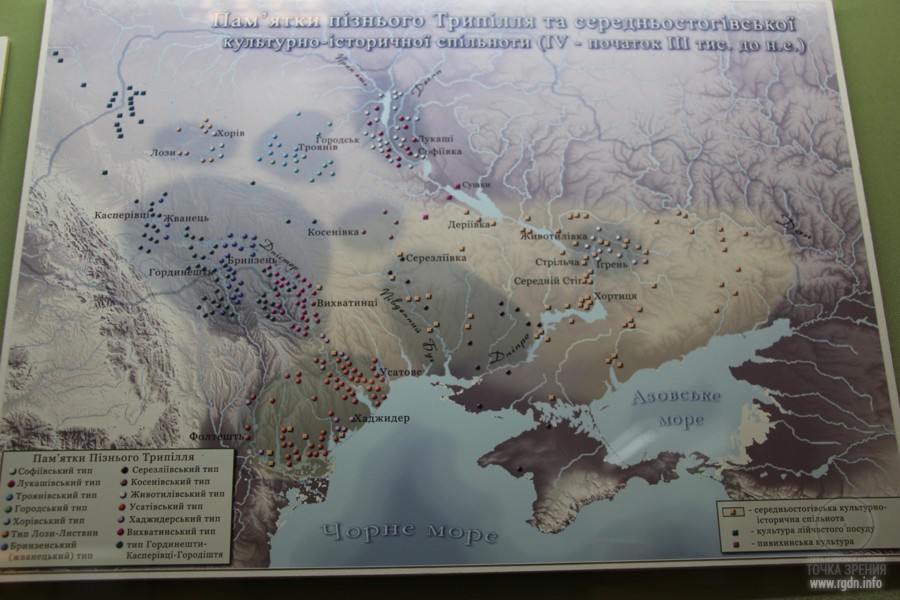
A map with indication of late local versions (types) spread in the territory of Ukraine (an image from the National Museum of the History of Ukraine)
E) Conclusions on Part 1:
The Trypillian culture general description has been given In Part 1, so that readers could more easily understand such a bright and distinctive phenomenon as Trypillian anthropomorphic plastic art to which we are now proceeding. Let us go point by point, like in the previous section.
А) Origin
A tradition to make clay figurines was not unique for Trypillians whose figurines had their “relatives” and predecessors in other adjoining cultures of the late Stone Age, spread in the vicinity of the Cucuteni-Trypillian culture in Central and Southeast Europe. Such other cultures included Turdash – Vinča (5700-4200 BC), Lendel (4900-3400 BC), the Linear Band Ware culture (5500-4000 BC), Boian – Karanovo V (circa 4000 BC), and so on.
In all these items we can easily trace similar, kindred motifs applied when the figurines were made.
As of today, the total number of figurines discovered all over the area of the culture distribution is around 12 thousand, including about 3 thousand figurines found in Ukraine. There are over 100 settlements in the territory of Ukraine, where such artefacts have been found.
B) Classification
As it has been mentioned in Part 1, the Cucuteni-Trypillian culture existed for over 2.5 thousand years. Just like any phenomenon, over such a period of time it gradually transformed, passing through the following stages: emergence – formation – development – advanced period – decline – extinction. This got further reflected in various local versions of the culture (there are about 60 of such versions today, as we’ve said above). Therefore, such cultural phenomenon as TAPA was constantly developing and transforming, too, and also had its regional differences.
Historians and archaeologists study all the trends, analyse and classify figurines. For example, famous archaeologist Mikhail Videyko notes the following:
Figurines are very different by their overall appearance, poses, gestures, and decorative elements. There are more than fifteen various images embodied in Trypillian terracotta items, including the Bird Goddess, the Snake Goddess, the Cow Goddess, Oranta, Madonna, paired female deities, Androgyne, and Warrior.
A chart from the Encyclopaedia of the Trypillian Civilization demonstrates how major types of figurines were developing by periods:
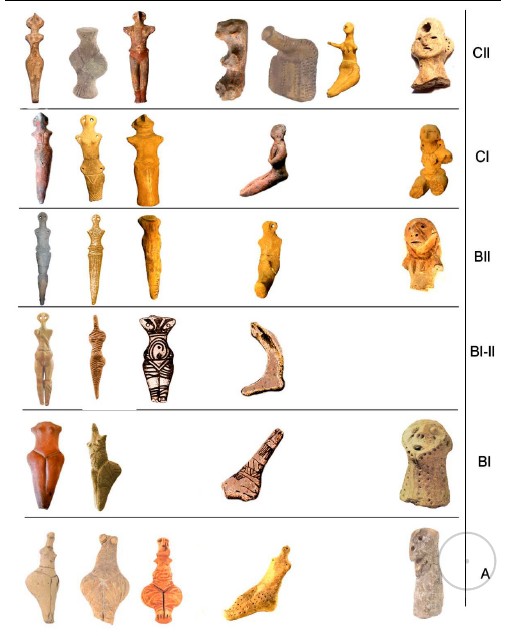
|
A figurine from Usatovo |
As we can see in the chart, as the culture was developing figurines were becoming more refined. While at the initial stage (А) those were wide-hipped female images (such shape is typical for nearly all Palaeolithic figurines globally), in the advanced period (beginning with ВІ-ІІ) and at the culture later stages those were rather slim virgins, often with pregnancy features. Researchers associate the latter symbol with the agrarian cult of fertility, which was widespread in all ancient agricultural communities.
|
A figurine from Usatovo
Figurines vary in sexual characteristics – female, male (though there are much less male ones than female ones), androgyne (combining features of both sexes), and children’s (e.g. stylised figurines of a child in mother’s arms).
|
Male and female figurines from Maidanetske (depository of the Institute of Archaeology under the National Academy of Sciences of Ukraine) |
Madonna with a child from Krinichki |
|
An androgyne figurine from PlaTar collection |
An androgyne. Koshilovtsy |
As for androgynes, historian and philosopher Mircea Eliade suggests that this phenomenon may be explained as a universal and sexless deity, which at the earthly plane may combine features of both sexes. |
Apropos of this, researcher Natalia Burdo mentions the following:
In ancient mythology androgyne is a dualistic character with female and male features. It symbolises the principle of balance between the two opposite principles (masculine – feminine, active – passive), reflected in anthropomorphic codes. Androgyny is determined by both the idea of unity that preceded diversity of the world, and the idea of the primordial chaos and non-division of the universe between heaven (the male principle) and earth (the feminine principle).
Figurines also differ in poses – standing or sitting. Near the sitting figurines, mostly at the earlier stages of the culture, stylised little chairs were often found. Researchers call some of them “horned”, since their backs are shaped as horns with their edges pointing upwards.
|
|
Such “horned” images, or a crescent with its horns pointing upwards as a component of the ancient AllatRa sign, were often depicted on ceramics as well as on clay models of Trypillian houses. There are also figurines with “hats” having a shape of a crescent with its horns pointing upwards, which provides some researchers with a ground to associate such female images with lunar symbolism and call them Lunar Goddesses. Moreover, some researchers believe that the placement of such figures on a chair-throne emphasises a special status of women in the society. |
|
|
Goddesses on horned chairs from Poduri, Romania
A circle is a symbol of the Soul. A crescent with its horns pointing upwards is a symbol of the generative feminine principle. |
|
|
A chair-throne shaped as two goddesses (PlaTar collection) |
Another difference is in design technique. There are figurines with drawn ornaments, painted ornaments, or with punctures, and there are those with almost no ornaments but only sexual features marked.
|
Conic-headed figurines from Bernovo-Luka settlement, Ukraine |
A figurine with a disc-shaped head from Oselovka, Ukraine |
The next feature is the head shape. There are figurines with conic heads, which is the earliest type. Researchers assume that heads for such figurines could be made of breadcrumb and placed on a cone when rituals were performed. Furthermore, there is a disc-shaped-head type of figurines, which spread at Trypillia BI stage. Finally, there are figurines with realistic features. Such type existed to a certain extent at nearly all the stages of the culture development, but was most widespread during the advanced period. Let’s consider this type in more detail, because these figurines are more expressive than others. |
|
|
Caracuşenii Vechi, Moldova |
|
Poloniste, Ukraine |
|||
|
|
It should be noted that a distinctive characteristic of TAPA items with realistic features is individual modelling of every figurine’s face. There are no two identical images even within one archaeological site. Although the realism of images is relative, figurines do communicate a certain emotional state which we can see in the faces of the samples presented above. |
|||||
In her monograph Realistic Plastic Art of the Cucuteni-Trypillia Cultural Complex, archaeologist, Candidate of Historical Sciences Natalia Burdo states:
The most widespread finds among realistic sculptures are female images with faces looking upwards.
Then she draws the following conclusion:
… most figurines with closed eyes depicted a standing female figure with her body slightly leaning back and her face looking upwards, reproducing the Oranta (Orans) pose. Closed eyes and the pose of such figurines may indicate depiction of sacral characters in the state of meditation.
Such conclusion once again evidences that ancient peoples possessed knowledge and practices, which favoured individual spiritual evolution. At that, the more such knowledge was available in a given society the more harmoniously the society was developing. Later on we will go back to this point.
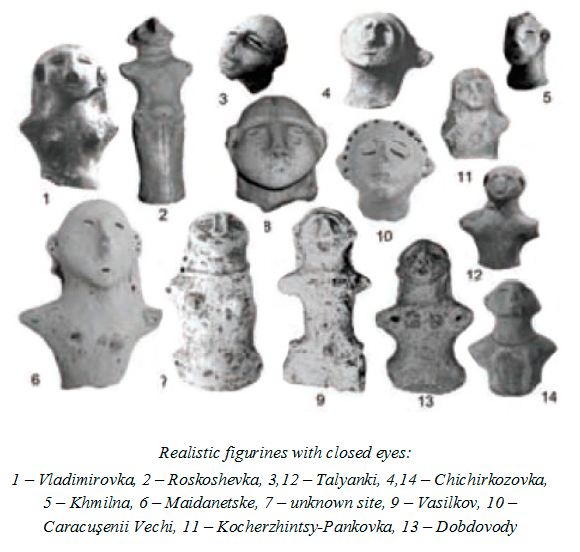
There are also the so-called zoo-anthropomorphic types, i.e. figurines that combine animal and human features, e.g. bird-woman, bird-snake, and so on. Such images are widely present in Trypillian art in various forms, and are indeed unique and original.
|
The Snake Goddess from Krasnogorka, Kherson Region, Ukraine (2900 BC), and a snake image from Ancient Egypt. Since ancient times snakes were considered mediators between heaven and earth, and the snake (serpent) image symbolized advancement through certain stages of spiritual self-improvement. |
|
A bird-woman (PlaTar collection) Since ancient times the bird image signified connection with the spiritual world. Echoes of such ancient beliefs may be traced even today. For example, in Christianity a pigeon (earlier a dove) is a symbol of the Holy Spirit. |
I shall omit all the external signs which a person begins to see and understand owing to amplification of his or her intuitive perception, and shall tell only about the principal inner sign that appears when such person steps on that bridge or path, i.e. when he or she enters the final battle with his or her animal nature for the soul supremacy in a given body. This sign appears in a form of head of an ancient reptile, serpent or dragon. But most often people start seeing as if an open-hood cobra is gazing at them. Its gaze is not aggressive, but serene. It looks eye to eye, most likely even at one’s nasal bridge. At that, a person sees its image in front of oneself both with closed and open eyes. (A. Novykh. Birds and a Stone)
We will discuss the snake image in more detail in Part 3 of this article.
Let me finish this subsection with another quote by N. Burdo:
There is no doubt that Trypillians achieved top craftsmanship in embodiment of sacral images in realistic sculptures in the late Eneolithic, when the majority of kindred farming cultures had already disappeared from the historical scene of Ancient Europe.
C) TAPA purpose
As it has been partially mentioned in the previous subsection, figurines had a worship purpose and bore a certain sacral meaning.
Let me draw your attention to the word sacral. It originates from the Latin word sacrum which means “sacred”, “dedicated to God”.
|
|
|
This word also has another interpretation that may be found in medicine where the word sacrum means the aitchbone. The latter is a large triangular bone located at the spine base. Moreover, the aitchbone shape resembles a triangle with a down-pointing apex – an ancient symbol of the feminine principle. Such symbol is widely represented in Trypillian art, including figurines. |
In other words, the aitchbone is a spine base, whereas the spine is the base of the entire body. Hence, it may safely be said that the word sacral means “basic”, “fundamental”, while the knowledge of the human spiritual nature and the universe are sacral and basic for any harmonious and constructive society. Let’s note these points!
Now it is time to consider where and in which conditions all the aforesaid artefacts were discovered. What does archaeology say on the matter? Researchers assert most figurines were found near ruins of temple buildings. They were piled in household pits located almost near every building. Such pits represent places where constructors took clay to build houses; later on, in the process of settlement functioning they got filled with household refuse. Archaeological records indicate the remains of figurines got accumulated in the pits throughout the period of temple functioning.
Famous archaeologist and Trypillian culture researcher Mikhail Videyko states that figurines, just like everything else used for sacrifices, were not thrown away, but protectively hidden in the ground. He also mentions that:
Judging by cleavages, most figurines were broken in remote antiquity. The ordinary world was not a proper place for the items that got in touch with great powers and bore a particle of magic, so Trypilians buried everything they used during rites and rituals. Hence, traces of sacrifices are usually found in pits.
It is hard to say definitely for which period of time a figurine was used, or whether it was a one-time use in a certain rite, sacrificial offering or series of rites.
|
Experimental burning of a reconstructed Trypillian house |
|
Figurines are also found in ruins of burnt temples. Such figurines are mostly intact. It is known that Trypillians had a ritual of settlement abandonment, when all buildings were abundantly filled with gifts (ceramics, foodstuff, cult items, etc.) and the settlement got burnt, while its population moved to a new place of residence. Some buildings could be burnt even when the settlement was still functioning. However, in the ruins of burnt dwelling houses almost no figurines were found. This is another evidence the figurines had a purely cultic purpose.
|
Researchers have difficulties with saying what the specific purpose of figurines was, for there are no written sources of information. There can be diverse interpretations only, based on the experience of a given researcher. They mostly limit themselves to saying that the figurines were used in various archaic agrarian cultures, rites and rituals associated with fertility.
D) Sets of figurines and sacral numbers
Not many people are aware that Trypillians used figurines not just separately, but in whole sets. The number of figurines in sets was different. According to archaeologists, such sets are usually found in vessels used for “magic practices” or beside such vessels. In one settlement several such sets could be found. Here are images of some artefacts of this kind.
|
|
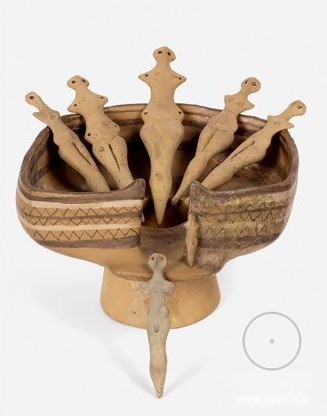 |
|
|
This set was discovered in the early 1980s near Poduri-dealul Ghindaru in Romania. It consists of 21 figurines and 13 little chairs. All the figurines are different in size, shape and ornament, but they may be grouped by certain features. Unfortunately, excavations at the site where the set was found have not been completed, and the figurines were without any container that would have guaranteed their intactness. The find dates back to the Pre-Cucuteni – ІІ phase. Researchers interpret it as a gathering of women for some ritual or sacral action; or, since the figurines are different in size, this could also be an action of initiation. Furthermore, it may be assumed that the women gathered for a joint spiritual practice. As for the number of the figurines (21), some researchers associate it with the female menstrual cycle. |
As we can see, when such sets are found the vessels are often far from being intact. Moreover, frequently only fragments of figurines are discovered, which complicates identification of a specific number of figurines in a given set. Nonetheless, there is a find that makes it possible to determine such number precisely!
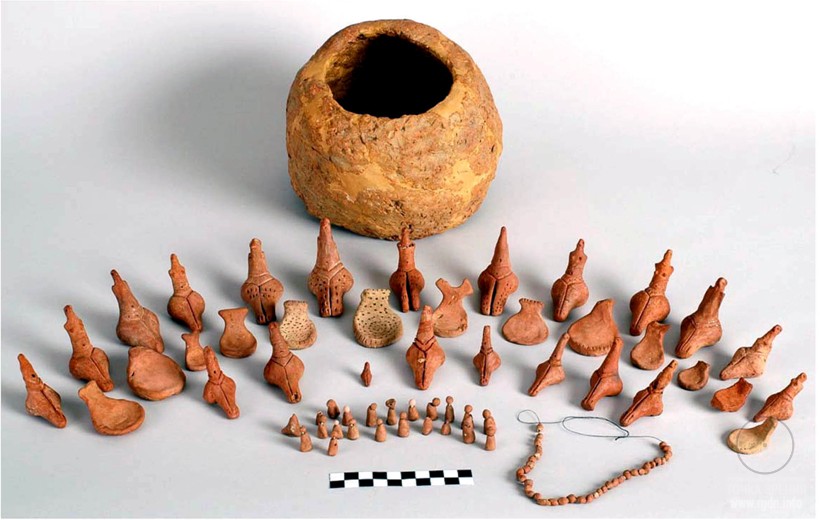
This unique set is from the village of Isaia – Balta Popii, Romania. It was discovered in 1999 by the Romanian archaeologist D. Monah. The set of figurines was found in an intact vessel with a closed lid, so it is a complete, integral complex! This set, just like the one described above, consists of 21 female figurines and 13 little chairs. The figurines are different in size, shape and ornament, but they may be grouped by certain features. The chairs are also different. Most probably, this set of figurines symbolised a certain gathering. The artefact is dated to the Pre-Cucuteni – III phase (4750-4600 BC).
|
|
Reconstruction. Sets of 4 figurines in vessels have been discovered in Galaest and Buzhna. |
According to researchers, such sets of female figurines were spread mostly at the early stages of the culture development, more specifically in Pre-Cucuteni (5050-4600 BC) – Trypillia А (4850-4350 BC). Later on, female figurines with little chairs disappeared, and mixed figurines emerged. That took place starting from Trypillia ВI (4350-4050 BC).
At the aforesaid stage population of the Trypillian land considerably increased, causing swift growth of the number and the area of settlements, as well as substantial complication of the social structure. Densely populated regions appeared, and the whole complex of material culture transformed. Due to such factors, as researchers mention, local connections and close relationships became topical and important for Trypillian communities, which echoed in TAPA of that period. At that, despite the drastic changes in the society, religious beliefs remained rather stable.
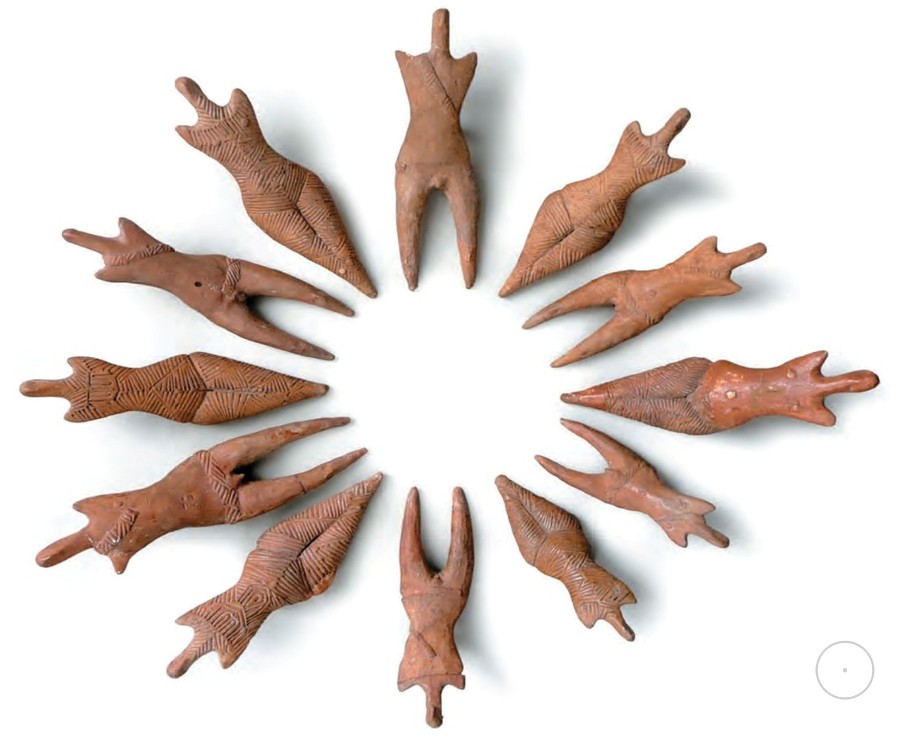 |
This set of figurines from Dumești, Romania differs from the previous sets by its composition, shape and decoration of the figurines. It represents a gathering of 12 figures (6 male ones and 6 female ones). The male figures may be distinguished by the sexual organ, separated legs, and the belt put across the shoulder, and they are quite uniform. The female figures are executed in a refined way and decorated with diverse geometric ornaments. |
As we can see, all participants of the gathering are in the Oranta (Orans) pose, i.e. their arms are raised upwards. We may assume they gathered for a sacral action, e.g. a prayer or a joint spiritual practice.
Finishing this subsection, I can only mention the aforesaid sets of figurines have been found mostly in the Balkan and Carpathian regions and mainly date back to the early stages of the culture. As of today, about 12 such sets are known.
E) Conclusions on Part 2:
As we can see, TAPA typology is quite broad and diverse. At that, we have gradually approached the next part of our review, where we will talk about one more type of figurines – ones with sacral symbols on them. What can signs (ornaments) on such figurines specifically mean?
Nothing is written about this in mainstream science sources, since such aspects cannot be touched or measured, and they are far from philosophical reflections, though being rather concrete and practical. This knowledge represents the most valuable information that our ancestors wanted to communicate to descendants, having coded it in a symbolic way on clay figurines. The knowledge is extremely important for each of us because it is timely nowadays. It may be used as a tool for self-improvement, by means of which everyone has an opportunity to feel the spiritual world and learn the sense of one’s arrival to this world. Every human personality gets a chance to transform oneself spiritually. Moreover, this knowledge enables a person to preserve a harmonious, though very subtle, balance in our highly complex contemporary society. As of today, a key to this lost Knowledge is contained in the AllatRa book by A. Novykh, which is freely accessible on the web.
It should be noted that one can look into these aspects only from the perspective of gaining one’s personal experience in learning of the spiritual world and in daily inner self-improvement work. However, this method of learning is beyond the logic of the material world, and is based solely upon intuitive perception of reality through feelings, which perception should be developed in oneself. Nonetheless, logic as a tool of learning is not refuted at all.
Perhaps, there is no sense in writing a lot about this – it is better to gain one’s personal experience. After all, one who practices does Know!
Now let us look at specific specimens together.
А) The human energy structure and marking of the Soul
The AllatRa book mentions that the knowledge of the Soul and the human spiritual nature existed in the human society from time immemorial. This statement is supported by numerous artefacts of various world cultures, including the artefacts of Cucuteni-Trypillia.
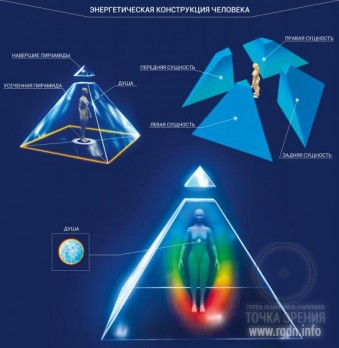 |
The book further mentions that the Soul is located not in the physical body, but in the human energy structure. In particular, around the Soul there is a highly complex structure shaped as a four-sided pyramid with a detached top, which structure is simultaneously situated in six (6) dimensions. The pyramid sides represent the so-called four main Aspects of a human being. In the detached top of the pyramid, there is the spiritually-natured Personality. The latter is separated from the Soul by the field-structured consciousness, but preserves a link with the Soul! In ancient times the linking “channel” was called the silver thread. If projected on the physical body, the Soul is located in the solar plexus area. |
|
|
A diagonal cross symbol from the AllatRa book, with the marked Centre and Sides (seal-type interpretation of the symbol). |
A diagonal cross in a rhombus. The rhombus is a projection of the pyramid base split into four zones. Dots mark the Aspects. |
In ancient times, when there was no written language, the knowledge of the human energy structure and the Aspects was schematically recorded by means of signs and symbols.. Below we will consider how this knowledge was reflected in artefacts of the Cucuteni-Trypillian culture. |
An equilateral diagonal cross with a circle in the middle is a symbol of the Knowledge about the four human Aspects and the Soul. A diagonal cross symbolises movement in learning, conventional division of space into fields (zones) of the Aspects’ influence, whereas a circle signifies the Soul. (A. Novykh. AllatRa)
Now let us see how the knowledge of the Soul was reflected on TAPA figurines.
|
5100 BC |
5100 BC |
5100 BC |
(From the book The Eneolithic of the USSR) |
Looking at the above items, we can see a clear mark on the solar plexus area where the Soul is located within the energy “body”!
Thus, taking into account such artefacts, we may conclude that Trypillians possessed the knowledge about the Soul since the earliest period of their culture existence. Moreover, should we trace this aspect deeper, we would see similar marks on the figurines of Vinča culture which preceded and was kindred to Cucuteni-Trypillia.
Now let’s look at figurines with the Soul marked on them, which have been discovered in the territory of Romania.
The artefacts shown in the last two images were found at Drăguşeni-Jura site in Romania. The images are taken from the book Aspectul regional cucutenian Drăguşeni-Jura by V. Sorochin.
B) Solar plexus. Chakras. Lotus. Shambala
|
Solar plexus
Solar plexus area in the human body
Major chakras in the body
Human energy structure |
|
As it has been mentioned above, the Soul is situated in the human energy structure, at the level of the solar plexus. The latter is far from being a simple organ. The solar plexus (Plexus coeliacus in Latin) is a complex of nervous elements concentrated in the abdominal cavity. By its shape this nervous centre resembles the sun because of the nerves radiating from it in different directions, and this is the origin of its name. Via the sympathetic and parasympathetic nerves the solar plexus is connected with the brain. Furthermore, some physiologists call the solar plexus the third (or abdominal) brain, and such fact can tell a lot to an attentive researcher.
Nevertheless, the AllatRa book says the physical body located in the 3rd dimension is only one of components of the highly complex human structure. In its essence it’s a mere tool to learn the material world, therefore its capabilities are quite limited. At that, every human being also has a subtle material body, the components of which include psycho-and-energy centres – chakras. A chakra (Sanskrit चक्र) means a circle, wheel, or disc. A person may use his or her subtle material body as a tool for learning and spiritual development, via performance of various meditative and spiritual practices. This body is also an integral part of the human energy structure described above. It should be noted that all the functional elements of the aforesaid structure form a SINGLE AND WHOLE human being.
|
The following artefacts indicate how the knowledge of the chakras was reflected in TAPA:
|
An artefact scheme in The Eneolithic of the USSR |
Alexandrovka, Ukraine, 5000 BC |
On many figurines there are punctures, hollows or oblong cuts on the head crown. It is interesting that such marks are found on anthropomorphic artefacts, e.g. of the kindred cultures of Karanovo and Vinča. Researchers have no idea what such hollows symbolise. However, if we compare such marks with the layout of chakras on the human body, the picture becomes clearer: at the head crown there is the “thousand-petal” chakra or chakran, which gets activated in many meditative practices.
|
Maidanetske, Ukraine |
|
|
|
A fragment of a bird-headed figurine with a spiral on the head crown. Bird images signified connection with the spiritual world. Vinča culture |
|
|
The processes taking place in the energy body during meditations and spiritual practices were sometimes schematically depicted on figurines as spiral vortices. Such symbols are found on artefacts of many ancient cultures and were often drawn on figurines near the area of the Soul location or slightly lower – in the abdominal area where the Hara chakra (chakran) is situated.
|
|
Scânteia, Romania, 4500-4100 BC Museum of the History of Moldova, Jaşi
|
Sokoltsy, Ukraine, 4500 BC
|
Speaking of the movement of energies, it is appropriate to mention the serpent image that has been already described in Part 2 of this article. This image was widespread in the Trypillian culture and played a particular role in the sacral field. For this reason serpent / snake images are frequently found on pottery and figurines. At that, let me present several quotes so that readers could compare relevant information on their own.
|
Yablona, Ukraine
|
Cucuteni, Romania |
Doctor of Historical Sciences Mikhail Videyko notes the following regarding serpent images:
|
||||
|
|
A snake goddess Krasnogorovka, Ukraine |
Here it is worth recalling the name of the energy that has a mighty generative potential and is concentrated at the human spine base. In yoga it is called kundalini, which in translation from Sanskrit means “twisted as a snake”.
|
||||
Based on the aforesaid information it becomes clear why the animal mind system so actively speculates about the sexual theme. After all, its task is to make people fritter away their priceless inner potential. Here’s another quote that explains everything:
At that, imagine what this power means for the invisible world where subtle effects and transformations take place and from where everything actually arises. In the spiritual aspect, sexual energy is a force, a conductor to deep inner feelings, so to say, to the world of the Supreme sacrament. (A. Novykh. AllatRa)
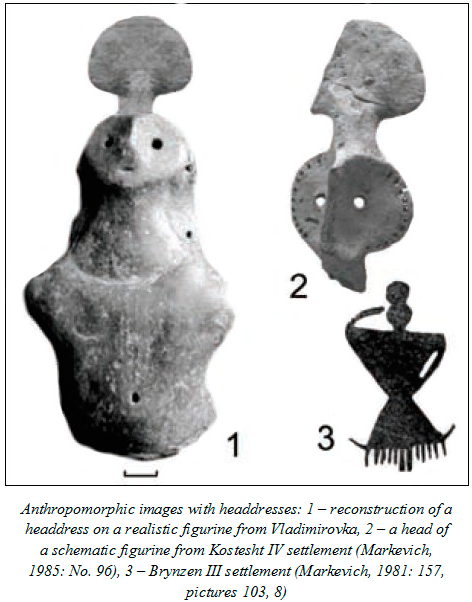 |
Yet, let’s go back to the Soul. According to Sensei of Shambala series by A. Novykh, from time immemorial there existed the knowledge of tools that helped a spiritual personality to get in touch or merge with the Soul – the substance originating from the spiritual world. Having merged with the Soul, a personality gets transformed, and his / her energy structure substantially changes. The person gains sanctity. It is interesting that the Russian word sviatoy (saint) originates from the Old Slavonic word svętъ meaning “light”. Furthermore, on Christian icons we can see that an “inherent attribute” of any saint person is an aura glow around his or her head, or a nimbus in the canon language. It is totally possible that these very processes are depicted on the ancient artefacts we consider herein. After all, we already know all the figurines had a sacral meaning, although researchers mostly believe the “round shapes” over the figures’ heads are peculiar headdresses… |
One of simple yet accessible self-development tools is the Lotus Flower spiritual practice, which is as ancient as humanity in this world.
The Lotus Flower spiritual practice was applied from time immemorial. Since olden times the Lotus was said to give birth to Gods. It’s been said God awakens in the Lotus, meaning that a divine substance – the soul – awakens in the Lotus Flower, in Harmony and Love inside. (From Sensei of Shambala by A. Novykh)
While performing this practice and focusing attention on the area where the Soul is located, a person immerses into a blissful feeling of love for everything in existence, experiences peace, harmony, silent joy, and inner balance. Perhaps, this very state is embodied in many figurines shown in Part 2 of this article, isn’t it? ...
The technique of this practice performance is described in detail in the books by A. Novykh.
The knowledge of the human spiritual nature is preserved in Shambala and brought by Bodhisattvas who “come” to the world in human bodies. Such Knowledge is usually renewed on earth at the junction of ages, more specifically in the Crossroad times. During such periods in history people stand on the threshold of another breakthrough in development, and new opportunities open for them. They are provided with spiritual assistance and granted a chance to build a civilization where spiritual values would prevail. Nonetheless, humanity reserves the right to choose whether to use this chance or not.
Let’s take, for instance, the Bodhisattva who was known under the name of Osiris a long time ago. His activity was connected not only with Ancient Egypt, but with the places known today as Altai, with the VolgaRiver Basin and the Dnieper and Danube region. He and his people did a great work which gave an impulse to cultures that flourished in the aforesaid seats of civilization. Even today a curious person can find some indirect proves, say, in Tripolye culture which appeared seven thousand years ago in the Dnieper and Danube region… (A. Novykh. Sensei of Shambala – Book IV)
|
Scherbanevka, Ukraine 4300 BC National Museum of the History of Ukraine |
Shambala Stamp – the three-petal lotus. Inside the lotus there is a pyramid with a detached top. In the central part of the base pyramid, in the area where the Soul is located, there is the Lord’s all-seeing eye. More about this symbol may be read in Sensei of Shambala – Book IV. |
|
Legends say that in later times in Slavic lands Shambala was called Belovodye. The symbol of Shambala / Belovodye is a three-petal lotus. Hence, it is no mere chance that in honour of the source of spiritual knowledge this symbol was depicted on the artefact shown on the left, right in the area where the Soul is located. The artefact itself is cross-shaped, whereas a cross is an ancient sign that symbolises a human being. There are other marks on this artefact as well. |
|
Osiris (Usir in Egyptian). An image on papyrus |
|
As for Osiris, let me add the following. Should we delve into ancient Egyptian mythology, we will see god Osiris was a totally real person who lived in Egypt. He was the one who taught Egyptians arable farming, gardening and basic crafts, gave them written language and ordered to comply with the laws of peaceful earthly community. After a while, Osiris’s personality became mythologized, and people started regarding him as a mere Judge of human souls in the next world. Nevertheless, all pharaoh dynasties recorded their genealogical lines exactly from him. As we can see in the above quote from Sensei of Shambala – Book IV, during his lifetime Osiris not only dealt with everyday issues important for Egyptians, but as the Bodhisattva he took care of the entire mankind, first and foremost renewing the lost knowledge about the human spiritual nature. |
In Egyptian iconography Osiris was often portrayed with a young three-petal lotus – the symbol of spiritual purity and true Knowledge. The lotus was growing from a seed from under Osiris’s feet. Lotus seeds preserve germinating capacity for up to a thousand years. For this reason the flower symbolises immortality, while its location indicates who has brought the knowledge of the Soul immortality to people. Four figures were drawn on the lotus flower, embodying the four Aspects in a human being.
It is impossible to determine accurately when Osiris lived. We may only assume it was in the pre-dynastic period of the history of Egypt. Today historians, relying on archaeological data, say such period was between the 5th and the 4th millennia BC, which timeline corresponds to the beginning of Cucuteni-Trypillian culture flourishing as TAPA items evidence.
Finishing this subsection, I view it appropriate to say a few words about the aforesaid four Aspects, since this information closely relates to the subject of the next subsection. Let me cite a relevant quote from the AllatRa book:
That is right, as I have already said, a lotus in this form was usually depicted as a symbol of the spiritual outcome of a Personality’s life path after the death of his or her body. A lotus with petals is a symbol of active life, and when petals fall off, the essence remains – spiritual seeds that a person has gained inside over his or her lifetime. The image on the papyrus symbolically shows the four main Aspects, like Witnesses, standing on the “essence”. Simply put, they represent information about each day a person has lived, so to speak, second by second. The notation above them, as a rule, displays symbolical marks of the count of “thoughts and deeds” (sins) of a person, as recorded by each Aspect. This is a sort of conventional indicator of the quantitative equivalent of the active domination of each Aspect over the life lived by the Personality. It is impossible to hide anything, all secrets are revealed. The four Aspects become like “silent Witnesses” that never lie. All the person’s deeds, thoughts, emotions, experiences, all temptations with what the person was seduced and what he or she chose throughout life – everything is there before the Judge (Osiris).
C) Diagonal crosses. The “sown field”. Chetverik
Let’s proceed to the next subsection.
So, in the late 6th – early 5th millennium BC the tribes that inhabited Southeast and Central Europe gradually entered a new stage in their development, which lasted for about 2 thousand years. That period may safely be called the age of innovations in material culture, because: 1) transition from appropriation economy (hunting, gathering and fishing) to production (farming and cattle-breeding) took place, which contemporary scientists call the Neolithic Revolution; 2) people learned to process metals (first copper and then bronze); 3) new, more up-to-date work tools appeared; 4) new methods of ceramics production emerged – a potter's wheel and a kiln were invented; 5) wheeled vehicles were invented; 6) division of labour began, and consequently 7) architecture became more advanced, and 8) proto-cities (large settlements with the population of 10 to 15 thousand people) emerged. The last factor was due to the overall growth of the number of people who were forced to settle in new territories, with a corresponding complication of the social structure of communities.
It should be mentioned that outbursts of civilization development during that period took place not just in Europe, but in other parts of the world as well, e.g. the Egyptian, Harappan (IndusValley) and Sumerian cultures / civilizations.
However, let us recur to Cucuteni-Trypillia and see how the epoch-making changes got reflected on Trypillian artefacts, including TAPA items, in particular as to sacral symbolism.
We already know that a certain work had been done by that time as to renewal of spiritual knowledge in the region. Hence, people were given tools for inner self-improvement, including such spiritual practices as the Lotus Flower, Chetverik and Pyramid. Changes in the spiritual and material planes influenced both figurine shapes and ornaments; in particular, geometric ornaments began to prevail. Furthermore, the following sign (see Figure 1 below) started appearing on figurines.
|
Figure 1 |
Plyskov, Ukraine 1st half of the 5th millennium BC National Museum of the History of Ukraine |
Researchers interpret this sign as a “sown field” and explain it so that: 1) the sign visually resembles a sown field, whereas Trypillian economy was then based on agriculture which was sacralised and worshipped as being directly dependent on soil fertility; 2) the sign was drawn on female figurines in the belly area, as another parallel with fertility; 3) figurines were used in agrarian rituals carried out in temples simultaneously with ritual bread baking; 4) on some figurines, remains of wheat grains were found in the holes of the sign (most probably, the grains had been inserted there in the process of rituals). |
Archaeologists’ reasoning is quite grounded, but the issue needs to be clarified. The thing is that many signs and symbols had both everyday material and sacral meanings, depending on how and where they were used. For instance, let’s take such an ancient widespread symbol as three wavy lines. Looking at the symbol, everyone will surely say it symbolises water, and this would be reasonable. Yet, in the sacral sense the symbol has another meaning, namely as a person’s immersion deep inside oneself, entry into the spiritual world or, speaking in scientific language, into an altered state of consciousness. Such interpretation of the symbol is understandable for people who have personal experiences in spiritual practices, while for those who don’t practice this will remain a symbol of water. Therefore, in the context of archaeological excavations, if such symbol has been found, say, as an element of temple wall paintings or was drawn on worship items, it will bear a sacral meaning rather than an everyday material one.
The same thing is with the “sown field” sign, which in Old Slavic sacral traditions was called Chetverik (“of four elements”) by the name of the spiritual practice that it symbolised. What could evidence this? Let us see more artefacts with the sign.
|
Romania |
Romania |
Cucuteni-Chetsetua, Romania (from The Eneolithic of the USSR) |
These are photos of artefacts where this sign is clearly visible. As we can see, the sign has different kinds of marks in its four “fields”. In such a way in all times knowledgeable people marked the activeness, controllability or prevalence of one or another Aspect in a human being. The Chetverik sign location on the belly of figurines also had a sacral meaning, since in this very place the Hara chakran is situated, playing an important role in the Chetverik practice. Figurines are further decorated with other sacral symbols – spirals which we have mentioned above, as well as horizontal lines that may indicate a dimension with which a person who made the figurine or the one whom the figurine symbolises worked.
Let me present more photos.
|
Rusestii Noi, Moldova |
|
|
|
Here I view it relevant to tell more about the sacral symbolism of an equilateral diagonal cross. As it has been written above, such symbol is indicative of the knowledge about the four Aspects (sides) of a human being and the Soul (centre).
|
Cruciform altars on ceramic models of Trypillian houses. 1, 2, 4, 5 – PlaTar collection; 3 – Sushkovka (National Museum of the History of Ukraine); 6 – Cherkasov Garden (Odessa Archaeological Museum) |
This sacral symbol was widely present in Cucuteni-Trypillia culture, e.g. in temples. Archaeological records show that temples in Trypillian settlements started to be built since the early stages of the culture development, and an altar was a mandatory element in all of them. At the early culture stages, altars were mostly round, square or rectangular. As the culture was advancing, an equilateral diagonal shape of altars with a hollow in the middle began to spread. A clay bowl may have often been placed in the middle instead of the hollow. Such bowls or hollows served as a place for fire – the symbol of the Soul. Altars were made of clay and were painted with ornaments. It is interesting that such shape of altars was used not only in temples, but in every Trypillian dwelling house as well. |
|
A seal-type scheme of the diagonal cross from the AllatRa book |
A clay model of a Trypillian house (PlaTar collection) An altar with a hollow
|
A fragment of a house model – a cruciform altar with a bowl (PlaTar collection)
|
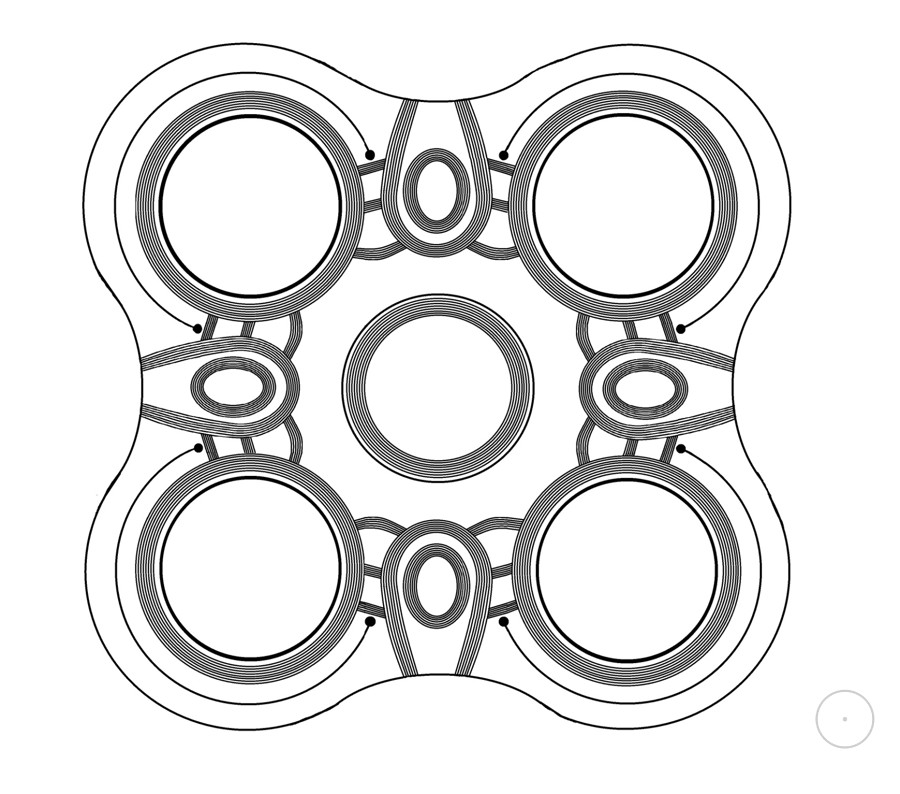
A scheme of a cruciform altar excavated in 2012 by an international archaeological expedition near the village of Nebelevka in Kirovograd Region, Ukraine
|
The altar at the excavation site |
The altar exhibited in the museum after restoration |
|
|||||||
|
Orientation of cruciform altars on ceramic models of Trypillian houses: 1 – Cherkasov Garden (Odessa Archaeological Museum); 2, 3 – PlaTar collection |
Just as other altars, this altar was made in the shape of an equilateral diagonal cross with its “blades” deviating from the cardinal directions by 45 degrees. Upon excavations this structure of 4.3 metres in diagonal length was extracted as a single monolith. It has been restored and is now exhibited in Kirovograd Museum of Regional Studies. |
|
|||||||
|
Reconstruction of the mega structure called for convenience the NebelevkaTemple. The temple was located in a Trypillian settlement near the village of Nebelevka (aerial survey data indicate the settlement area was about 300 ha, and the settlement dates back to the late 5th – early 4th millennium BC).
|
The altar used to be in a temple of enormous dimensions – 21 х 60 metres, which consisted of two floors with galleries and a patio. As many as 7 altars have been discovered in the temple ruins. The largest one had a round shape and about 5 metres in radius. The altars were decorated with drawn ornaments and painted in white and red. Judging by the burnt surface, archaeologists have concluded that fire was often burnt in the altar centre. Such structures as the NebelevkaTemple expressively evidence not only advanced monumental construction skills, but the evolved spiritual culture of Trypillians as well. |
||||||||
|
A ceramic pot, Romania |
Signs on pottery. From The Eneolithic of the USSR |
Originating from the spiritual plane, the diagonal cross symbol was reflected in the material plane, too. Therefore, such symbol is found not only on ritual attributes, but on household items as well, as a reminder of the duality of human nature and the supremacy of the spiritual. |
|||||||
|
Kolomoyshchina, Ukraine |
Usatovo, Ukraine. 2nd half of the 4th millennium BC. Odessa Archaeological Museum |
Diagonal cross marks on late Trypillian figurines It should be noted that researchers distinguish late Trypillian monuments such as Usatovo (Odessa Region, Ukraine) as a separate culture. As for the last image of the figurine from Usatovo, it is assumed that the cruciform notch on the figurine symbolises a shoulder belt for carrying a long dagger. |
|||||||
As a given culture is decaying due to various climatic and social shocks, the inner spiritual essence of knowledge is getting lost. Only external shapes such as signs and symbols continue existing for a long time as ornamental elements that became traditional. People copy signs and symbols from generation to generation because their ancestors did so. In his article Cosmogony and Mythology of Eneolithic Farmers, Academician Boris Rybakov points at the following aspects of millennia-long stability of ornamental patterns:

|
Traditional ornamental elements on a Ukrainian embroidery |
|
Such echoes of ancient knowledge as rhombic shapes, equilateral and diagonal crosses may be found even today, e.g. in ornaments on Ukrainian embroideries. |
D) Pyramidal shapes and other symbols
|
Fancy reconstruction |
|
First of all, let me mention that some researchers call the signs and symbols drawn on such figurines garment décor. At that, I would like to ask such researchers: if this is mere décor, how did the signs and symbols appear on garments, and why? Don’t they originate from the spiritual, sacral sphere? Other researchers assert geometric ornaments could symbolise folds on clothes (?), while pyramidal shapes on figurines represent a scheme of “body wrapping”, like that of Egyptian mummies. Not everything is so definite as it may seem at first sight, although every researcher interprets these elements based on his or her personal experience.
|
Well, I will leave this information for readers to judge and will comment nothing else in this subsection. Instead, let me cite several extracts from the AllatRa book by A. Novykh and add some relevant artefacts to that.
… from the perspective of a higher dimension Observer, the human structure does not look the same as it looks in the three-dimensional world (with arms, legs, a head, and a trunk). It looks as a complex shape which more than anything resembles a four-sided truncated pyramid with its top detached. This is, of course, if we pick the closest association understandable for the thinking of a resident of the three-dimensional world. Owing to the Pyramid meditation, a person can feel one’s energy structure relating to the four Aspects, expand one’s perception and, most importantly, feel one’s Soul.
|
Drăguşeni, Romania. 4050-3900 BC. Museum in Botoşani, Romania
|
Rusestii Noi, Moldova. An image from The Eneolithic of the USSR |
||
|
Soloncheny, Moldova. 4400 BC. National Museum of the History of Ukraine |
Dumeşti, Romania |
Cucuteni, Romania. 4500 BC |
|
… most often the symbol of a diagonal cross (or its variations) in sacred texts pointed at the Knowledge about the energy structure of man, about his Aspects and interconnection with dimensions. Dimensions were represented for convenience as a number of steps in a truncated pyramid or a staircase, elements of patterns (lotus buds or petals, contours of mountains, zigzag lines), circles inside a circle, little lines, grains, or dots. As a rule, their number was 3, 4, 5, 6, or 7.
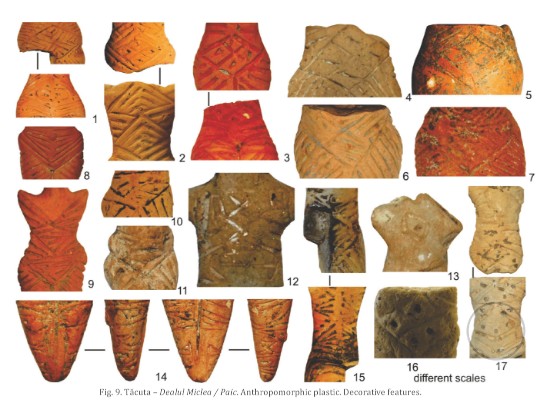
Tacula-Dealul Micfea, Romania
In the above image we can see that on some figurines there are pyramidal marks combined with the Chetverik sign, and there are other symbols and marks as well.
At that, the presence of seven identical elements in a pattern signified the 7th dimension that indicated a perfect person and the structure of the world up to the 7th dimension, or the concept of “heaven”, “Nirvana”, and “liberation of the Soul”. Sometimes 8, 9, 12, 13, as well as 33 or 72 conventional marks were depicted near the symbol of the seventh dimension, pointing at the knowledge about the Universe. Such sacral information was often recorded in patterns of ritual items, garments or sacred buildings.
|
|
|
Marks on the figurines discovered in Romania |
While working on this article your most humble servant endeavoured to get at the heart of the matter, thus seeking to approach analysis of relevant facts impartially. Hence, I have studied a certain scope of specialised literature and compared the information given there with the knowledge about the human spiritual nature as provided in the books by A. Novykh. In the process of my work it has become obvious to me that the topic is extremely profound and extensive. Therefore, there is every reason to say that this article is only a tip of the iceberg which has partly shown itself on the surface and expects to have more followers and enthusiasts.
Several millennia have already passed since the time when ruins of the last Trypillian settlements got covered with steppe grass, but thanks to archaeology today we can carefully touch the past at least a little in order to retrieve the most valuable in all times – knowledge and experience! Having no written language, Trypillians schematically recorded their knowledge and experience on clay items, applying diverse symbols and signs.
Numerous artefacts of the Cucuteni-Trypillia culture expressively demonstrate that, if the spiritual aspect prevails in society, material wellbeing will come, too. After all, when God is in the first place, everything else is where it should be! This is persistently asserted by the entire history of the Trypillian civilization whose representatives were able to create with their own hands that what scientists now call the Golden Age of Eneolithic.
It should be added that the most important in those times was not innovations and technology in pottery making or metallurgy, etc., but the knowledge of the spiritual nature that took humanity to a new level of evolution. By means of inner self-development tools a human being was able to overcome one’s animal nature and thus give a chance to one’s spiritual nature to evolve and to reach God as a totally different, spiritual being. What could be more significant and honourable?! …
Finally, for the readers who are interested in this subject and would like to look into it deeper, below I give a list of sources I used for this article.
Literature:
Prepared by Sviatoslav Sergeyev (Kiev, Ukraine)
 The Cucuteni-Trypillian civilization: anthropomorphic plastic art and its sacral meaning
votes:
202
The Cucuteni-Trypillian civilization: anthropomorphic plastic art and its sacral meaning
votes:
202
|

Project Aim










Leave comment